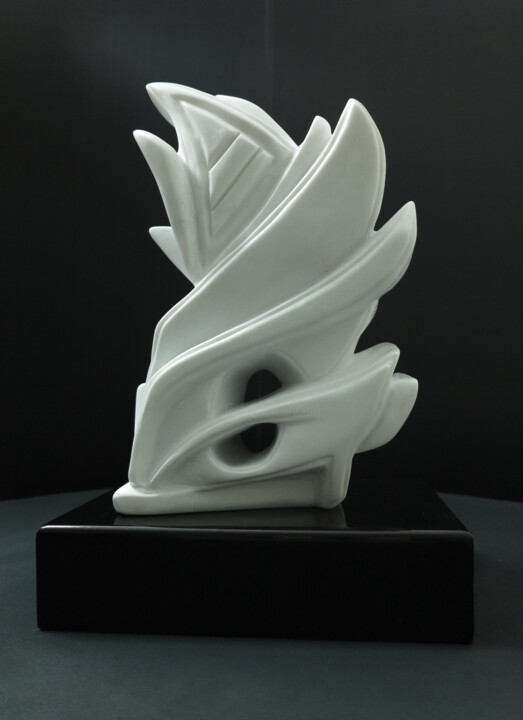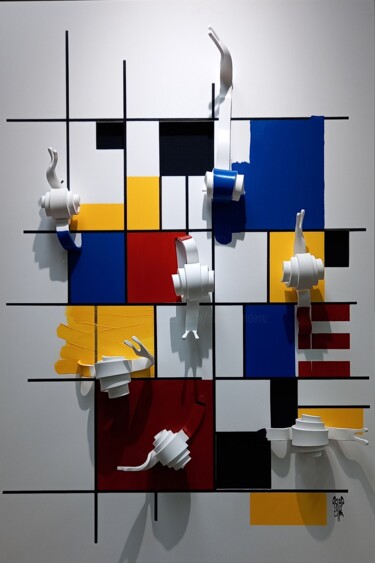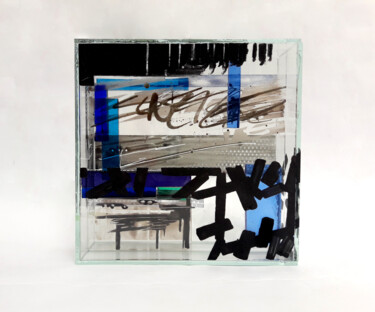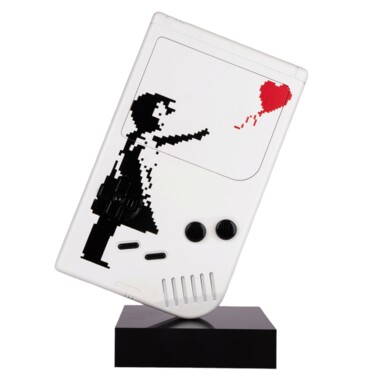189 Esculturas contemporâneas originais à venda:
Como definir estilo Arte urbana ?
Street Art is visual art produced in public spaces for viewing by the general public and is intended to spread a social and political statement. It has been referred to as "guerrilla art," "post-graffiti," "neo-graffiti," and "independent art." Street art is seen as the zenith of democratic art because it can be viewed by anybody and is not owned. Artists have introduced this unusual and democratic work into institutions and galleries throughout the past few decades, garnering recognition on a global scale and popularity in the "traditional" art world. The city and its residents have an impact on street artists' environment and sources of inspiration. Their main themes frequently examine ideas of popular culture, ads, cartoons, and urban settings. Street art is full of inventiveness and constantly looking for new techniques, supports, and materials, from the abstract to the figurative.
The fundamental idea behind street art is that everyone should have the opportunity to create art and have it seen by others, regardless of their race, age, gender, economic status, or other characteristics. It also believes that art should be accessible rather than hidden away inside galleries, museums, and private collections. Even though some street artists may make sculptures or installations, they are more well recognized for using uncommon art materials like wheat paste, spray paint, stencils, and stickers.
The most well-known artists of today developed their reputations on the streets. Graffiti artists like Keith Haring and Jean-Michel Basquiat, whose works were found on public walls as well as in galleries and museums, had a big impact on later generations of artists, particularly Banksy and Fairey. Street art has historically had a tense relationship with the art world as a whole due to its roots in illegal activity and distinctive interest in subversion, political, and social action.
Street Art sculpture
In sculpture, Street Art is a movement and a form of artistic expression characteristic of the late twentieth century, early twenty-first. Many sculptors have marked the history of this movement through his handling of volumes: this is particularly the case of Mark Jenkins and his hooded figures, but also of Isaac Cordal and his miniatures characters very critical of our social development, or the Gregos parisian with his persons making faces. Around the world, Street art sculpture continues to be a popular category of art and many of its creators have achieved renown and mainstream success.
Street Art Sculptors
Mark Jenkins (born 1970)
American artist Mark Jenkins creates sculptural street installations. Jenkins uses the "street as a theater" in his street art, allowing his sculptures to interact with the environment. With his hyperrealistic sculptures that he places in the streets across Europe and the United States, Mark Jenkins explores how people see the world. The staging is often uncomfortable and the faces of the people are frequently obscured. Since he wraps live figures in plastic films and tape, his technique is likewise hidden. The "cast" is then cut out, put back together without the figure, dressed, and given realistic features like hands and hair.
Gregos (born 1972)
French street artist Gregos began displaying his face on the buildings in Paris. He creates a reproduction of his face with his tongue out or smiling that he paints and adheres to the walls of Paris using his own 3D concept, which he designed utilizing all the techniques he had learned and refined over the years. Each face serves as a kind of self-portrait for the day, expressing the humor of the wearer and his past, present, and future.
The street art concept by Gregos is effective at encouraging conversation between the faces and among spectators. More than 500 faces have been installed so far, largely in Paris but also in other French cities and cities across the globe, including Europe, the United States, Japan, and South America.
Isaac Cordal (born 1974)
Isaac Cordal is a Spanish Galician artist who specializes in miniature art. His creations feature miniature animals built of cement, which is often thought of as the mark of civilization, and are positioned in unexpected places like gutters and puddles. Due to its small size (about 15 cm), finding them requires careful attention. They are frequently depicted in ordinary activities, and the setting choice can introduce new dimensions to the action. They typically highlight how ludicrous our current world is. The artist uses the sculptures as a metaphor to analyze politics, bureaucracy, and power.
Christiaan Nagel (born 1982)
Christiaan Nagel is a British street artist known for his oversized mushroom sculptures made from polyurethane which he places high up on buildings. They reach as far as Los Angeles, Cape Town, Berlin, Barcelona, London, New York, and Cape Town. These polyurethane mushrooms come in various sizes and individual samples or flocks. The artist claims that although mushrooms naturally develop, they require ideal weather and environmental circumstances, such as original artistic and scientific concepts.
Descubra esculturas contemporâneas de arte urbano na Artmajeur
As esculturas de arte urbano contemporâneo são um tipo de obra de arte original que ganhou imensa popularidade nos últimos anos. Os principais tipos de suportes usados para essas esculturas são paredes, prédios e espaços públicos. Os materiais utilizados incluem tinta spray, estênceis, madeira, metal e plástico, entre outros. O que torna este tipo de arte único é a sua capacidade de trazer a arte para as ruas e torná-la acessível a todos.

©2023 2mé / Blondeau
Origens e História
O movimento de graffiti, que começou na década de 1970, foi uma resposta significativa à falta de representação das comunidades marginalizadas no mundo da arte. Os artistas de graffiti usavam espaços públicos para se expressar e transmitir suas mensagens. Esse movimento levou ao surgimento da Arte de Rua na década de 1980. Os artistas de rua começaram a criar não apenas graffiti, mas também murais, adesivos, cartazes e esculturas usando materiais como metal, madeira e concreto. As Esculturas de Arte de Rua Contemporâneas continuam a evoluir, com novos artistas e estilos surgindo o tempo todo.

©2023 Sand
Evoluções desses trabalhos no mercado de arte contemporânea
As esculturas de arte urbana contemporânea passaram por uma evolução significativa nos últimos anos. O movimento, antes subterrâneo, ganhou reconhecimento mainstream, com artistas explorando novos materiais e técnicas para criar Obras impactantes. Isso resultou em um aumento do interesse no mercado de arte contemporânea, com colecionadores e investidores buscando essas peças únicas e provocadoras. A importância dessas esculturas está em sua capacidade de desafiar noções tradicionais de arte, criando um diálogo entre o artista e o espectador. Além disso, sua colocação em espaços públicos significa que elas têm o poder de transformar a paisagem urbana, tornando a arte mais acessível e inclusiva. À medida que o movimento de arte urbana continua a evoluir, será fascinante ver como os artistas navegam na tensão entre o sucesso comercial e a integridade artística.

©2023 Shelby Artista representado por Studio Tangerine
Artistas Famosos Relacionados
Artistas Contemporâneos que se especializam em esculturas de arte de rua são muito procurados por suas abordagens únicas e inovadoras a esta forma de arte popular. Esses artistas usam uma variedade de técnicas e materiais para criar esculturas impressionantes que capturam a essência da vida urbana.
Um desses artistas é um escultor conhecido por seu trabalho intrincado e altamente detalhado. Ele é altamente habilidoso em trabalhar com metal e suas esculturas frequentemente incorporam objetos encontrados e outros materiais para criar um efeito visual impressionante. Outro artista é conhecido por suas esculturas ousadas e coloridas que incorporam elementos de graffiti e arte de rua. Seu trabalho é altamente reconhecível e ganhou um grande seguimento entre os entusiastas da arte de rua.
Mais um artista é conhecido por suas instalações em grande escala que transformam ambientes urbanos em obras de arte. Suas esculturas frequentemente incorporam elementos da arquitetura e paisagem circundantes, criando uma integração perfeita entre arte e ambiente construído. Outro artista é conhecido por seu uso de materiais não convencionais, como plásticos reciclados e outros resíduos, para criar esculturas lúdicas e provocativas que comentam sobre questões de sustentabilidade e ambientalismo.
No geral, esses artistas contemporâneos são altamente habilidosos em sua arte e trazem uma perspectiva única para as esculturas de arte de rua. Seja trabalhando com metal, grafite ou materiais não convencionais, eles estão empurrando os limites do que é possível nessa forma de arte emocionante e dinâmica.

©2023 Sagrasse
Esculturas de Arte Urbana Contemporânea Notáveis
As esculturas contemporâneas de arte urbana se tornaram uma forma significativa de arte urbana, capturando a atenção do público em todo o mundo. Aqui estão algumas das esculturas de arte urbana mais renomadas e suas descrições:
A Garota Destemida - Kristen Visbal - 2017 A Garota Destemida é uma escultura de bronze de uma jovem garota parada confiantemente com as mãos na cintura, encarando o famoso Charging Bull de Wall Street. A escultura foi criada por Kristen Visbal e instalada em 2017 como um símbolo do empoderamento feminino e da diversidade de gênero em Wall Street.
Balanço - Roa - 2018 O artista belga Roa criou Balanço, uma escultura de um roedor gigante equilibrando-se em sua cauda, em 2018 em Melbourne, Austrália. A obra de arte foi inspirada na próspera população de ratos da cidade e em sua capacidade de se adaptar ao ambiente urbano.
Ame-me - Curtis Kulig - 2011 Ame-me é uma escultura das palavras "Ame-me" escritas em letras brilhantes e audaciosas. Criada pelo artista Curtis Kulig em 2011, a escultura foi instalada em cidades ao redor do mundo, incluindo Nova York, Paris e Tóquio. A obra de arte é uma mensagem de amor e positividade para o público.
KAWS: Férias - KAWS - 2019 KAWS: Férias é uma série de cinco enormes esculturas criadas pelo artista americano KAWS em 2019. As esculturas retratam seu icônico personagem Companion reclinado em vários locais ao redor do mundo, como Hong Kong, Japão e Estados Unidos. A obra de arte é uma interpretação lúdica e caprichosa de viagens e aventuras.
A Arma Entrelaçada - Carl Fredrik Reuterswärd - 1980 A Arma Entrelaçada, também conhecida como Não Violência, é uma escultura de bronze de um revólver com o cano amarrado em um nó. Criada pelo artista sueco Carl Fredrik Reuterswärd em 1980, a obra de arte tornou-se um símbolo de paz e não violência em todo o mundo e está instalada em vários locais, incluindo a sede das Nações Unidas em Nova York.
Em conclusão, as esculturas de arte urbana contemporânea se tornaram uma forma importante de arte pública, transmitindo mensagens de empoderamento, positividade e paz para cidades em todo o mundo. Essas obras de arte são um testemunho do poder da arte de inspirar e provocar reflexão.

Cyborg Corrigé
Escultura - artwork_cat. | 63x35x30 cm

Eric Vialla (Tweak)
Escultura - Metais | 38x130x44 cm

Jordan Jeffray
Escultura - Acrílico | 95x28x22 cm

Carole Carpier
Escultura - Resina | 21,5x6x8,5 cm
































